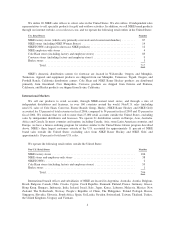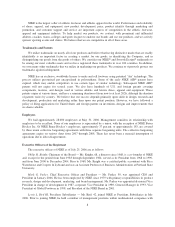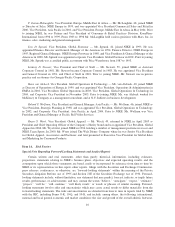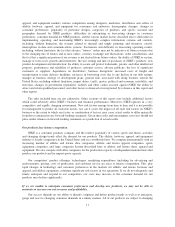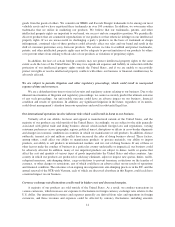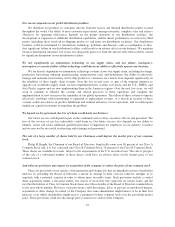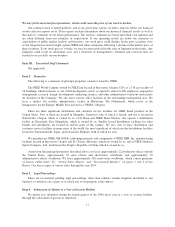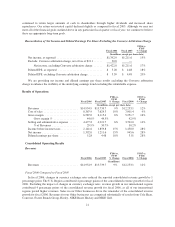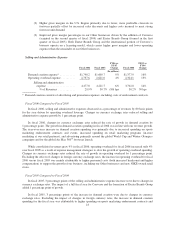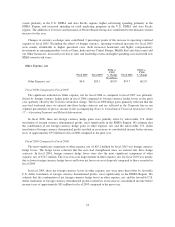Nike 2006 Annual Report Download - page 15
Download and view the complete annual report
Please find page 15 of the 2006 Nike annual report below. You can navigate through the pages in the report by either clicking on the pages listed below, or by using the keyword search tool below to find specific information within the annual report.goods from the goods of others. We consider our NIKE®and Swoosh Design®trademarks to be among our most
valuable assets and we have registered these trademarks in over 100 countries. In addition, we own many other
trademarks that we utilize in marketing our products. We believe that our trademarks, patents, and other
intellectual property rights are important to our brand, our success and our competitive position. We periodically
discover products that are counterfeit reproductions of our products or that otherwise infringe on our intellectual
property rights. If we are unsuccessful in challenging a party’s products on the basis of trademark or design
infringement, continued sales of these products could adversely affect our sales and our brand and result in the
shift of consumer preference away from our products. The actions we take to establish and protect trademarks,
patents, and other intellectual property rights may not be adequate to prevent imitation of our products by others
or to prevent others from seeking to block sales of our products as violations of proprietary rights.
In addition, the laws of certain foreign countries may not protect intellectual property rights to the same
extent as do the laws of the United States. We may face significant expenses and liability in connection with the
protection of our intellectual property rights outside the United States, and if we are unable to successfully
protect our rights or resolve intellectual property conflicts with others, our business or financial condition may be
adversely affected.
We are subject to periodic litigation and other regulatory proceedings, which could result in unexpected
expense of time and resources.
We are a defendant from time to time in lawsuits and regulatory actions relating to our business. Due to the
inherent uncertainties of litigation and regulatory proceedings, we cannot accurately predict the ultimate outcome
of any such proceedings. An unfavorable outcome could have an adverse impact on our business, financial
condition and results of operations. In addition, any significant litigation in the future, regardless of its merits,
could divert management’s attention from our operations and result in substantial legal fees.
Our international operations involve inherent risks which could result in harm to our business.
Virtually all of our athletic footwear and apparel is manufactured outside of the United States, and the
majority of our products are sold outside of the United States. Accordingly, we are subject to the risks generally
associated with global trade and doing business abroad, which include foreign laws and regulations, varying
consumer preferences across geographic regions, political unrest, disruptions or delays in cross-border shipments
and changes in economic conditions in countries in which we manufacture or sell products. In addition, disease
outbreaks, terrorist acts and military conflict have increased the risks of doing business abroad. These factors,
among others, could affect our ability to manufacture products or procure materials, our ability to import
products, our ability to sell products in international markets, and our cost of doing business. If any of these or
other factors make the conduct of business in a particular country undesirable or impractical, our business could
be adversely affected. In addition, many of our imported products are subject to duties, tariffs or quotas that
affect the cost and quantity of various types of goods imported into the United States and other countries. Any
country in which our products are produced or sold may eliminate, adjust or impose new quotas, duties, tariffs,
safeguard measures, anti-dumping duties, cargo restrictions to prevent terrorism, restrictions on the transfer of
currency, or other charges or restrictions, any of which could have an adverse effect on our results of operations
and financial condition. The outcomes of an ongoing investigation into anti-dumping practices in the EU, and the
annual renewal of the NTR with Vietnam, each of which are discussed elsewhere in this Report, could each have
a material impact on our business.
Currency exchange rate fluctuations could result in higher costs and decreased margins.
A majority of our products are sold outside of the United States. As a result, we conduct transactions in
various currencies, which increases our exposure to fluctuations in foreign currency exchange rates relative to the
U.S. dollar. Our international revenues and expenses generally are derived from sales and operations in foreign
currencies, and these revenues and expenses could be affected by currency fluctuations, including amounts
14


